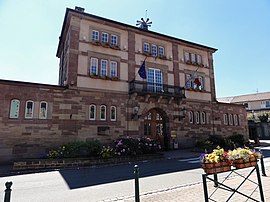world.wikisort.org - France
Wasselonne (French pronunciation: [vaslɔn]; German: Wasselnheim) is a commune based in the Bas-Rhin department in north-eastern France, more precisely, in the Grand Est region.[3] The oldest firm of unleavened bread in France: Etablissements René Neymann, is located in this town.
Wasselonne | |
|---|---|
Commune | |
 The town hall in Wasselonne | |
 Coat of arms | |
Location of Wasselonne  | |
 Wasselonne  Wasselonne | |
| Coordinates: 48°38′N 7°27′E | |
| Country | France |
| Region | Grand Est |
| Department | Bas-Rhin |
| Arrondissement | Molsheim |
| Canton | Saverne |
| Intercommunality | Mossig et Vignoble |
| Government | |
| • Mayor (2020–2026) | Michèle Eschlimann[1] |
| Area 1 | 15 km2 (6 sq mi) |
| Population | 5,711 |
| • Density | 380/km2 (990/sq mi) |
| Time zone | UTC+01:00 (CET) |
| • Summer (DST) | UTC+02:00 (CEST) |
| INSEE/Postal code | 67520 /67310 |
| Elevation | 195–380 m (640–1,247 ft) |
| 1 French Land Register data, which excludes lakes, ponds, glaciers > 1 km2 (0.386 sq mi or 247 acres) and river estuaries. | |
Population
| Year | Pop. | ±% p.a. |
|---|---|---|
| 1968 | 3,832 | — |
| 1975 | 4,172 | +1.22% |
| 1982 | 4,862 | +2.21% |
| 1990 | 4,916 | +0.14% |
| 1999 | 5,542 | +1.34% |
| 2007 | 5,571 | +0.07% |
| 2012 | 5,662 | +0.32% |
| 2017 | 5,652 | −0.04% |
| Source: INSEE[4] | ||
Geography
Wasselonne is located in the Mossig valley, in the Vosges foothills, near the Alsace Wine Route.
The town train station is nowadays closed. A bicycle path has been built in th eplace of the former railway.
History
In Roman times, Wasselonne was a vicus populated by the Triboci. The village was situated on the Durenberg hill and the left bank of the Mossig.
In the Merovingian period, Wasselonne prospered thanks to its proximity to Kirchheim, where a large and popular royal residence was established. During the 7th and 8th centuries, Wasselonne was certainly densely populated.
At the beginning of the 15th century, Wasselonne Castle was described as one of the most important fortresses in Lower Alsace.[5] It was the seat of the bailiwick of Wasselonne. The stones used for its construction were extracted from the pink sandstone quarries of the Kronthal, identical to those used for the construction of Strasbourg cathedral.[6]
In 1447, the Wasselonne War (1446-1448) pitted the Grand Chapter of Strasbourg against William, Count of Fénétrange and Walther von Dahn, who held the imperial fiefdom of Wasselonne from 1425 to 1483. Wasselonne was besieged and taken by the latter, then recaptured by Strasbourg troops who set fire to the castle in 1448.
The conflict officialy ended when Walther von Dahn sold the castle and the village to the city of Strasbourg, in 1496, for 7,000 florins.
Between 1811 and 1919, Wasselonne was the second largest tanning centre in the Bas-Rhin, Strasbourg being the first one. It was overtaken by Barr during the next decades.[7]
During the Second World War, eleven Jewish people from Wasselonne were deported by the Nazis and never returned from the extermination camps. To this list should be added the Protestant Henri Roederer who died in 1943. The only Jewish survivor of the camps is Jean Samuel, who died in 2010.[8] He deported to the Auschwitz extermination camp with the writer Primo Levi, who made him the character of Pikolo in his book If This Is a Man.[9]
Monuments
Wasselonne is known for its castle, which has been partially destroyed in 1674. The remains of this munument, a big circular tower and a square tower, can still be seen nowadays.
See also
References
- "Répertoire national des élus: les maires". data.gouv.fr, Plateforme ouverte des données publiques françaises (in French). 2 December 2020.
- "Populations légales 2019". The National Institute of Statistics and Economic Studies. 29 December 2021.
- INSEE commune file
- Population en historique depuis 1968, INSEE
- "Le Château de Wasselonne". Ville de Wasselonne (in French).
- Nohlen, Marie-José (2008). La construction de la cathédrale gothique de Strasbourg - La grâce d’une cathédrale sous la direction de Mgr Joseph Doré (in French). Strasbourg: La Nuée Bleue.
- Stoskopf, Nicolas (1987). La petite industrie dans le Bas-Rhin (in French). Strasbourg: Éditions Oberlin.
- "Jean Samuel". Le judaïsme d'Alsace et de Lorraine (in French).
- Samuel, Jean (2007). Il m'appelait Pikolo : un compagnon de Primo Levi raconte. Jean-Marc Dreyfus. Paris: Laffont. ISBN 978-2-221-10909-0. OCLC 173348456.
На других языках
[de] Wasselonne
Wasselonne (deutsch Wasselnheim, elsässisch Wàssle) ist eine französische Gemeinde westlich von Straßburg, ehemalige Hauptstadt des gleichnamigen Kantons, heute angegliedert an den Kanton Saverne im Département Bas-Rhin in der Europäischen Gebietskörperschaft Elsass und in der Region Grand Est. Sie liegt im Zentrum der elsässischen Ebene, auf halbem Weg zwischen Straßburg und Wangenbourg-Engenthal an den Hängen des Mossig.- [en] Wasselonne
[es] Wasselonne
Wasselonne en idioma francés y oficialmente, Wasselnheim en idioma alemán, es una localidad y comuna francesa, situada en el departamento de Bajo Rin en la región de Alsacia.[fr] Wasselonne
Wasselonne [vaslɔn] (en alsacien Wàssle) est une commune française, ancien chef-lieu de canton, désormais rattachée au Canton de Saverne dans le département du Bas-Rhin, en région Grand Est.[ru] Васлон
Васло́н (фр. Wasselonne) — коммуна на северо-востоке Франции в регионе Гранд-Эст[1] (бывший Эльзас — Шампань — Арденны — Лотарингия), департамент Нижний Рейн, округ Мольсем, кантон Саверн[2]. До марта 2015 года коммуна являлась административным центром одноимённого кантона (округ Мольсем).Другой контент может иметь иную лицензию. Перед использованием материалов сайта WikiSort.org внимательно изучите правила лицензирования конкретных элементов наполнения сайта.
WikiSort.org - проект по пересортировке и дополнению контента Википедии